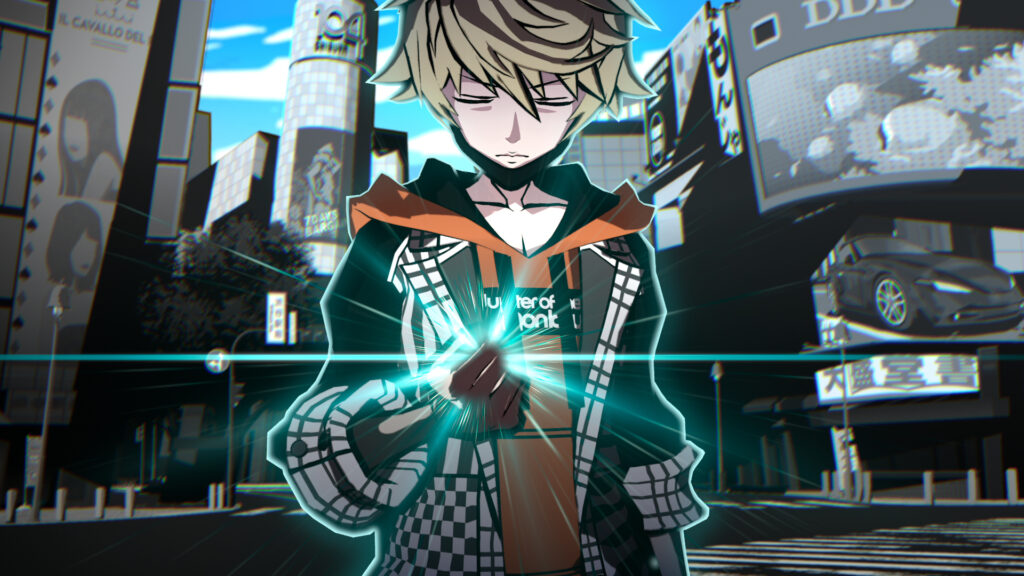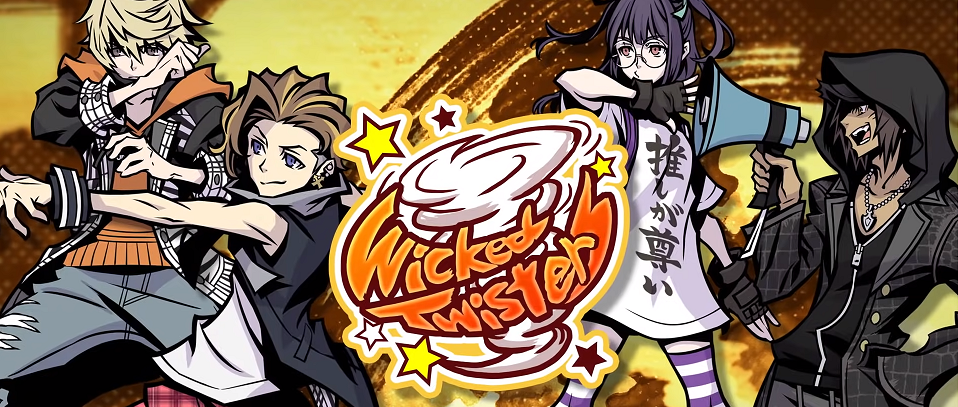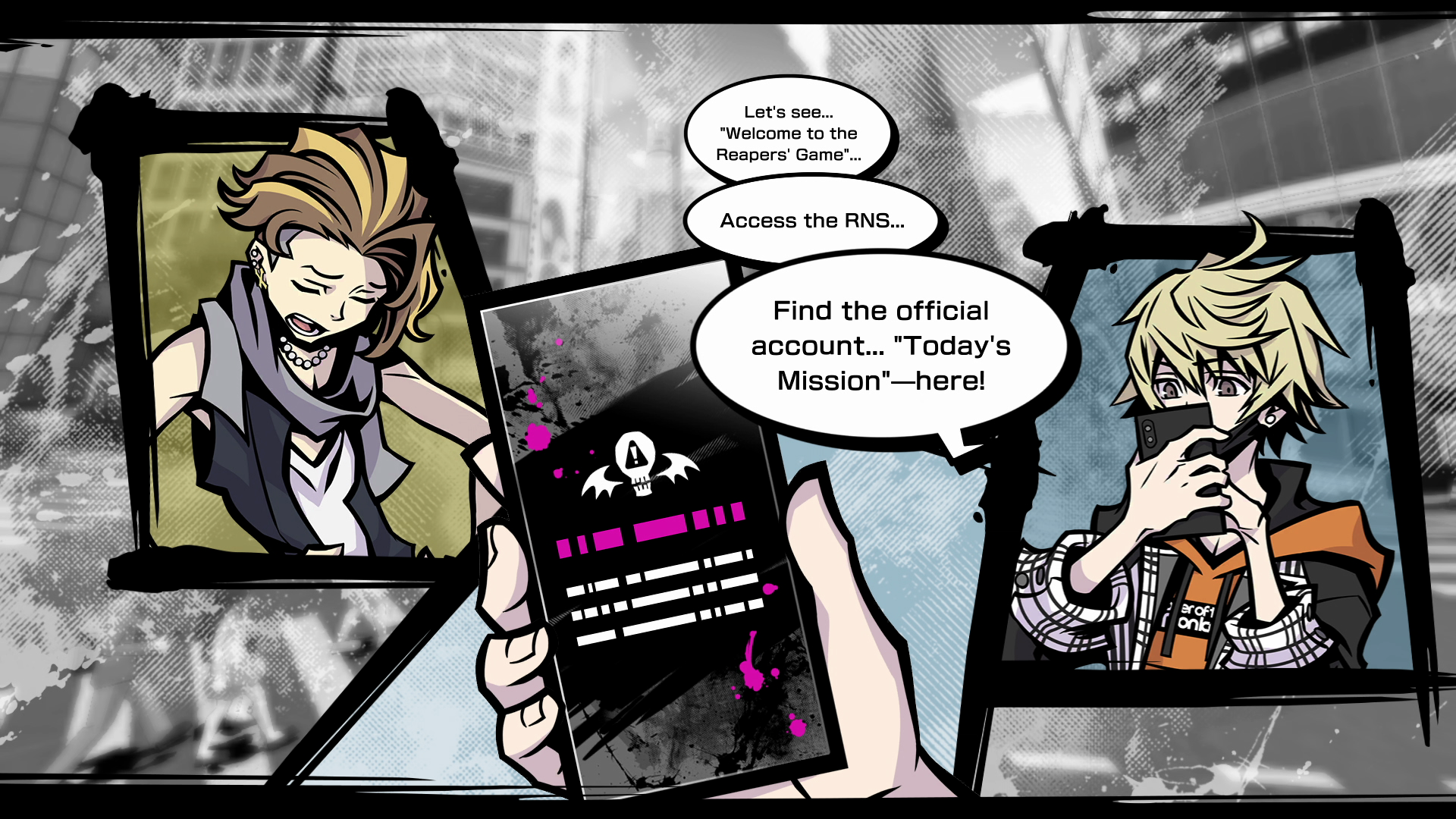It wasn’t until the balmy summer of 2019 that I finally sat myself down and checked out The World Ends with You. I played the Switch port, which I understand has some noteworthy control issues, but the game jived with me nevertheless. The jive was strange; it felt more than a bit like showing up alone at an indoor pop-rock concert with no idea what to wear. But every time that’s happened to me in life — OK, admittedly it’s only happened once — I’ve eventually settled in and enjoyed the sights and sounds.
One might be inclined to think, then, that showing up at the proverbial concert again for NEO: The World Ends with You would be an easier exercise. After all, this long-awaited sequel shares a great deal in common with its 2007 predecessor. The setting, Tokyo’s famous Shibuya district, is shared between installments. As is everything that makes Shibuya Shibuya — the nonstop barrage of flashy signs, the wild assortment of shops; the feeling that you’re caught up in a human whirlwind.
That straightforward assumption, that strong hope that NEO would dig its downright strange hooks into me as its predecessor did and seldom let me go, has proven itself to be mostly correct. NEO is not without flaw, but the good so steadily outweighs the bad that it’s an easy recommendation to anyone craving that most elusive of JRPG combinations: weird and good.
Among the more obvious things NEO: The World Ends with You cribs from its aging Nintendo DS forefather is its basic premise. To be sure, there are twists. Clever fans of the first game may seem some of them coming, but worried veterans needn’t fear that the whole thing plays out like before. But yes, protagonist Rindo Kanade and friends quickly find themselves trapped in a funky metaphysical urban sprawl. And yes, they find themselves unable to escape a contentious allegiance to the sort of “anime dungeon masters” you may have seen in a dozen shows. (But few among them are as groovy as TWEWY‘s Reaper variety.)
Dancing to the tune of your Reaper overlords means battling memorable creatures. Many of them are odd twists on familiar creatures. Others are powerful bosses that may require more than a bit of grinding. (More on that later.) All of them are worth experiencing firsthand, so I’ll refrain from going into details despite the relatively late timing of our review.
None of these encounters hold a candle, however, to the sentient and sometimes endearingly stereotypical rival teams the Reapers pit Rindo and his posse against again and again. Each team, including your own Wicked Twisters, shares a common goal that’s impossible not to empathize with. They simply wish to live. Without delving into spoilers (although again, those who have played the original TWEWY can safely presume they know what’s going on), this is a game of persistent elimination. When a team is eliminated, well… tough going, old chums. Tough going.
It’s dangerous to go alone. Take this.
In a bit of Good Omens witchcraft (or should I say Life is Strange: True Colors?) the people of Shibuya all possess certain sorts of auras reflecting the present state of their souls. You typically can’t interact with them directly, but through recognizing the nature of their plight you may find yourself giving them a bit of spiritual comfort or even combating the corruptions compelling them to sadness or malice.
There’s a lot of humor in NEO, though your mileage may vary regarding its effectiveness. The Wicked Twisters are chock full of contemporary pop culture quotes and mannerisms, all conveyed quite well through the game’s creative art style and smartphone debates and diatribes. (If you, like me, were constantly shocked that Ryuji Sakamoto in Persona 5 texts with perfect punctuation and grammar, “Fret” not; these teenage texts are precisely what you’d expect.) You might find yourself wishing one of the main party members would cool it with all the oddball mathematical vernacular; on the other hand, maybe you’ll have a greater tolerance for it than I did, in which case carry on merrily. Personally, I’ve found myself laughing along more with what a few of the more distinctive rival team members tend to say, which adds a thick layer of sadness sometimes when you’re up against them in cerebral puzzles, or pulse-pounding races, or good old-fashioned contests of pain.
Traversing Shibuya means getting down and dirty with its eclectic fare. As you’d expect, there are shops available to upgrade your gear. Addictively, this gear can gain additional ranks over time, adding a welcome extra customization suite into the game’s lively mix. It’s beyond the conventional equipment dives that Tokyo springs to life: restaurants, bookstores, and more are equally inviting and all blend into NEO‘s mostly-harmonious leveling system. Several times throughout my adventure I was surprised by how in-depth these shop-based systems can go.
The World Ends with You made quick work of the Nintendo DS’ dual-screen technology. Combat was appropriately frantic as players swiped the screen to trigger certain actions. One of the more contentious reasons some fans feared we’d never see a console-based sequel is the lack of such controls beyond the DS and its 3DS successor hardware. I’m impressed with Square Enix’s ability to maintain a similar rhythm with traditional controllers.
You’ll quickly become accustomed to the concept of “pins,” all-powerful little gadgets that affect a character’s inner traits, attack types, and even their elements. As the game goes on, you’ll unlock an assortment of new pins. They’re able to evolve over time after a fashion, and the key to battlefield victory often rests in understanding the synergy that pins between your party can provide. It’s a bit akin to deckbuilding with a tried-and-true “gotta catch ’em all” flavor.
If there is a qualitative arena NEO: The World Ends with You fails to succeed in, it’s keeping things fresh across the course of the campaign. I’ve seen more than a few harsher reviews, from harsh critics and more modest-minded players alike, lamenting the game’s doldrums. These momentum-nuking affairs commonly occur with the same setup: Rindo has a vision of something going horribly wrong, the day proceeds apace, Rindo’s vision comes true, and time travel gives him a second chance to amend the ordeal and progress to the next day.
It’s a nifty notion. It’s just that it happens several times too many. After the first few instances, an air of predictability pervades it all, and some players may be left wondering what it was all for. It’s bad enough that I can genuinely see this being a make-or-break for people whose gaming time is especially limited, but it never threw me off entirely.
An argument can also be made that NEO feels less personal than its predecessor. Shibuya’s size is a double-edged sword; for all its splendor, Rindo never quite connects with its denizens the same way TWEWY‘s Neku did. It’s not a huge flaw, at least not to me, but it does cause a few narrative moments to fall flat on their face by comparison. I’m not sure I’d say the main party gels as well as Neku’s, either, but it’s by no means for lack of trying. Nagi could have used a real arc rather than merely reacting to her friends but beyond that grievance, the character writing is solid if unspectacular.
Returning composer Takeharu Ishimoto infuses NEO with everything fans could conceivably except, perhaps, for a few more original tracks. The soundtrack broadens as the story continues, and many of Ishimoto’s remixes of his original TWEWY tracks are phenomenal. In fact, there’s truly nothing bad to be said about a single track, old or new; I just wish we had more of the new, even at the potential expense of the old.
Some folks can’t help but scroll to the bottom of every review they read and then work their way through from the beginning thereafter, so if you’re here at the final paragraph wondering what it all means, NEO: The World Ends with You is a worthy sequel that’s mostly worth the ludicrously long wait. There are warts, but there is plenty of beauty to behold. The story hits similarly lofty beats and the gameplay is terrific. Thankfully, a Spotify release of the soundtrack just recently dropped. It’s smart, it’s funny, and it’s chock full of fashionable attire. It’s also periodically weakened by stale sequences that ought to have been revamped. The major characters can’t quite compete with Neku and his gang, but there’s plenty to love from their rivals. NEO: The World Ends with You is a welcome return to the Reapers’ Game.
Version tested: PlayStation 4




Recent Comments